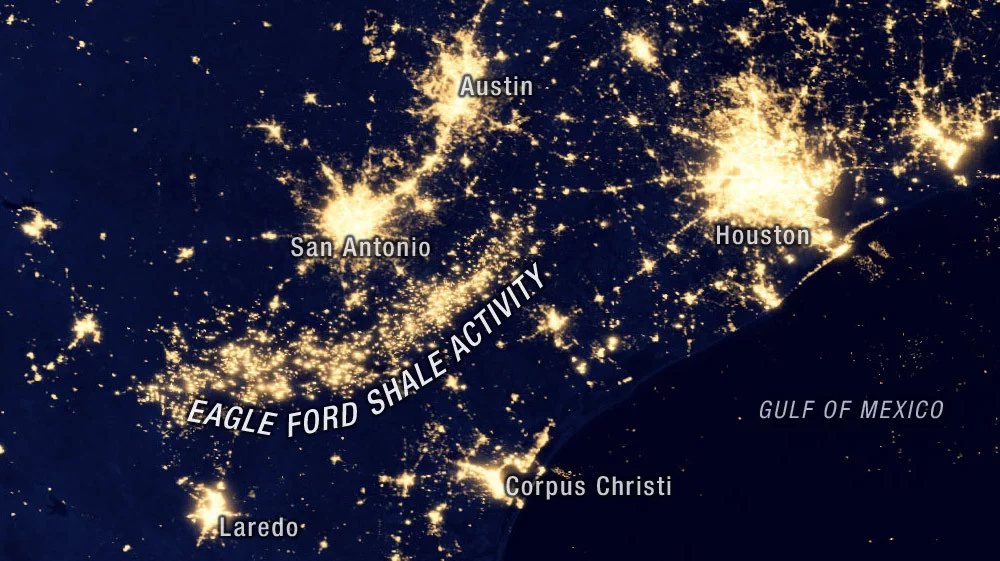If you were to fly into space above Texas at night and look down, you might see something surprising. You could look down and see clusters of light pollution and probably recognize the big cities: Houston, Dallas, Austin and San Antonio. You could even make guesses about other clusters on the fringes: Amarillo, El Paso, Laredo, Brownsville and Corpus Christie would each have their own glow. Maybe you’re from a small town and can even guess which little dot is home. But what about all the other scattered specs of light around South Texas and West Texas? What are those?
You don’t have to go to outer space to see what we are talking about. The specs of light are visible on Google Earth’s earth at night setting, and captured in various other satellite images. Need a hint? The lights are coming from the Permian Basin and Eagle Ford Shale oil and gas fields. No, they’re not artificial lights from equipment. They are flames from lit oil and gas flares – thousands of them lighting up Texas every night.

Flaring is intentionally burning natural gas at the drilling site or refinery, and it is a common practice in the oil and gas industry when excess gas that companies cannot store or sell is simply burnt away, releasing methane and other harmful chemicals in the process. These flares are the mysterious lights from space, but even if there are no lights, the harmful chemicals associated with flaring can still be released.
Oftentimes, the wind might blow out a flare, or the flare is not lit to begin with, but the methane and volatile organic compounds continue to spew out of the oil and gas rigs and refineries. This is called venting, and it is also extremely dangerous to human health because many of the chemicals released are more harmful if they have not been burnt. Plus, venting could be happening nearby without anyone even knowing.
What makes flaring so harmful? First, let’s start with methane. While not directly harmful to human health, methane is very bad for the environment because it contributes to climate change. Like carbon dioxide, methane is a greenhouse gas that gets stuck in the atmosphere and causes the planet to heat up to dangerous levels, but methane heats the planet at about eighty times the rate of carbon dioxide.
Tell the EPA to #CutMethane by putting the toughest rules they can on methane emissions and flaring!
Climate change is the driving force behind many of the extreme weather events we have been seeing in recent years. From Hurricane Harvey, to even hotter than normal summers, to Winter Storm Uri, these extreme weather events are becoming more common as climate change disrupts normal weather patterns. Moreover, if methane emissions are not cut back, we could see increased sea-level rise, droughts, and more extreme weather that disrupts our way of life.
In addition to the long-term effects of climate change, flaring also has an immediate effect on the health of communities that live near the flares. The volatile organic compounds that flaring and venting release can linger in the air and cause serious health problems. According to research, Latinos are much more likely to live near flaring than Whites, so our communities are disproportionately experiencing these negative health effects.
One of the most common effects of breathing this toxic air is the development of asthma, which can linger for an individual’s entire lifetime, costing thousands of dollars in healthcare. Preterm births are also linked to the chemicals released during flaring, and experiencing a preterm birth can be life-threatening situation for the mother and the child, who if they survive, may live with complications of the preterm birth for their entire lifetime. Lastly, the overall cancer rates are higher in communities that are located near flaring than they are elsewhere.
The solution is clear; we must do everything possible to stop or greatly reduce the amount of flaring happening, especially in Texas, where it is so common that it can be seen from space. Luckily, the Environmental Protection Agency, EPA, is considering passing a new rule that would do just that. The rule has not passed yet, so we still have time to make a difference.
The EPA accepts written public comments weighing in on each rule they consider. We have until the January 14th deadline to urge the EPA to pass the strongest possible rule limiting methane emissions and stopping flaring. The health of our planet and our community is at stake, so there is not time to waste.